Why nuts?
Nuts are natural power-packs of nutrients like vitamins, minerals, antioxidants, healthy fats, protein and fibre which help children grow, develop and learn. Examples of nuts include almonds, Brazil nuts, cashews, chestnuts, hazelnuts, macadamias, pecans, pine nuts, pistachios and walnuts.
What about peanuts?
Peanuts are technically a legume, but they are commonly referred to as a nut as they have a similar nutritional composition.
What is a serve?
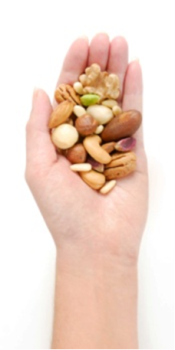
A 30g serve of nuts is a small handful, or roughly:
- 30 pistachio kernels
- 20 almonds or hazelnuts
- 15 cashews, pecans or macadamias
- 9-10 Brazil nuts or walnuts
- 4 chestnuts
A serve of nuts contains approximately:
- 36% of a child’s daily vitamin E requirement
- 13% of a child’s daily fibre requirement
- 4g protein and
- B-group vitamins, calcium, iron, zinc, potassium and magnesium
Health benefits of nuts
Regularly eating nuts as part of an overall healthy diet can help to reduce cholesterol, regulate blood pressure, reducing the risk of diabetes and heart disease, maintain regular bowel movements and even support bone health!
Remember:
- Nuts like cashews, Brazil nuts and macadamias are packed full of nutrients, protein and fibre to help children grow, develop and learn.
- A serve of nuts is 30g or a small handful.
- Eating nuts regularly can benefit your overall health in so many ways.
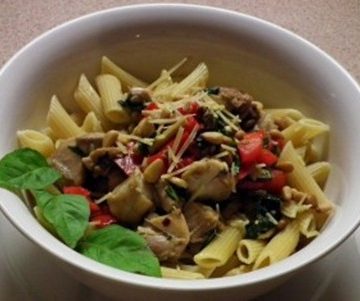
Pronto chicken and vegetable pesto pasta recipe
Kids will love this simple and balanced mid-week meal.
Nuts and kids
Nuts can be eaten on their own as a quick and healthy snack or used to add crunch and variety to recipes.
Raw or dry-roasted and unsalted nuts are the healthiest option. Nuts with added salt or sugar should be avoided where possible.
Nuts should be introduced in the diet from six months of age, just like other foods. Children under five should avoid whole nuts due to the risk of choking. Nut pastes or ground nuts are a good alternative.
Adding nuts to your child’s diet
Try these yummy ideas to help your kids get their healthy handful daily:
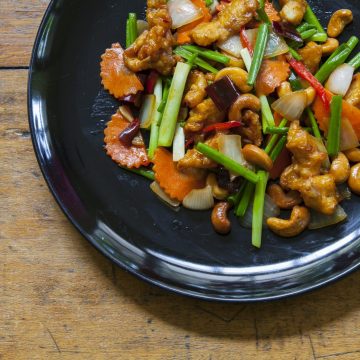
- prepare a trail mix for snacks or school lunchboxes (if permitted by your school)
- toss almonds or cashews through a stir-fry
- add roast chestnuts or pine nuts to a salad
- sprinkle roasted, chopped hazelnuts or pistachios over soup
- chop macadamia as a crust on grilled fish
- crush pecans over low-fat yoghurt and fruit
- add walnuts to home-made banana bread
- add chopped nuts to muesli, porridge or a wholegrain breakfast cereal
- a pure nut spread on toast, or as a sandwich filling, or in celery sticks
- Visit www.nutsforlife.com.au or our recipe section for more ideas
- and a selection of nutritious recipes to include nuts in your family’s diet
Nuts in schools
Plain or dry-roasted nuts are rated GREEN according to the National Healthy School Canteens Guidelines, which means they are a nutritious food that should be on the canteen menu every day (if your school allows them).
Remember:
- Enjoy nuts as a snack or add to your favourite recipes for some crunch.
- Avoid nuts with added salt or sugar
- Introduce nuts to your children’s diet form six months of age as a nut paste or ground nuts.
- Children under 5 should avoid whole nuts due to potential choking risks.
- Nuts should feature on the school canteen menu is policy allows.
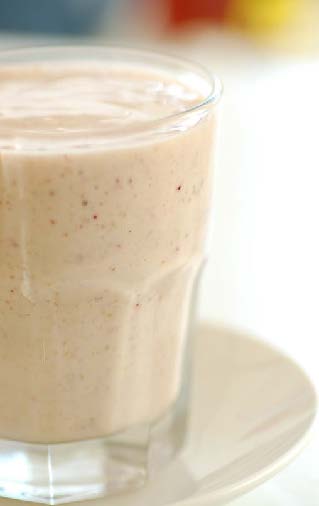
Banana booster smoothie recipe
What kid doesn’t enjoy a creamy, sweet smoothie. With the inclusion of LSA mix – this recipe includes a punch of nutty goodness!
Nuts and allergies
Peanuts and tree nuts can cause allergic reactions in some children.
If your child’s school chooses to have a nut free policy the following nuts/nut products should not be included in the foods your child brings from home:
- Almonds/ almond butter
- Brazil nuts
- Cashews/ cashew paste
- Chestnuts/ ground meal
- Hazelnuts/ ground meal
- Macadamias
- Mixed nuts
- Peanuts, peanut butter/paste, peanut flour, peanut oil
- Pecans
- Pine nuts
- Pistachio nuts
- Walnuts
- Marzipan (almond)
- Nutella spread (hazelnut)
- Praline, Baci (hazelnut
- Arachis (peanut)
- Rhen flakes (peanut)
- Satay sauce (peanut)
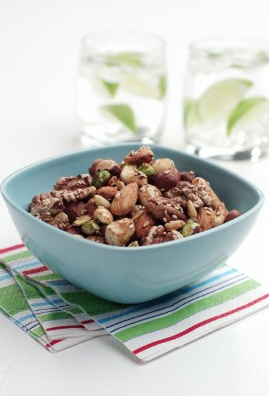
Foods commonly containing nuts* include:
- Textured or hydrolysed vegetable protein
- Friands and flourless cakes (often contain almond meal)
- Flavoured cheeses (fruit and nut, walnut)
- Peanut and satay sauce (peanut based)
- Nut filled chocolates (can be peanut or other nuts)
- Baklava, Greek pastry (walnut or peanut)
- Marzipan icing, confectionery or cake decorations (usually almond based)
- Praline, fine nut (usually hazelnut) product added to desserts and chocolates
- Nut biscuits such as Amaretti, macarons, Florentines (almond)
- Crushed nuts on top of desserts e.g. cakes, fruit buns, ice cream
- Breakfast cereals
- Muesli bars and health bars
- Energy mixes or trail mix
- Fruit crumble mix
- Christmas cakes and puddings
- Nougat and fudge
- Pesto
- Salad dressings
- Fruit cake icing (marzipan)
- Waldorf salad (walnuts)
- Asian style meals
- Worcestershire sauce
* Adapted from Nut allergy, Healthy Eating Advisory Service, State Government of Victoria, 2014, http://heas.health.vic.gov.au
Check the label
Packaged foods that contain nuts must state this on the label. You can also look for the statement ‘May contain traces of nuts’ which indicates there’s a possibility of cross-contamination during the manufacturing process.
Remember:
- Peanuts and tree nuts can cause allergic reactions in some children.
- Avoid taking nuts or foods containing nuts if your school has a nut free policy.
- Check the label to see if products contain nuts.
Produced by Nutrition Australia Vic Division, October 2014. Reviewed July 2021.




